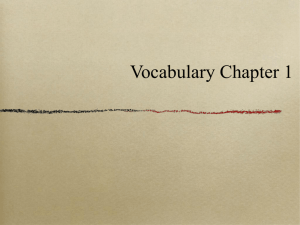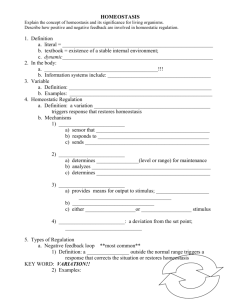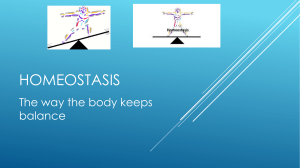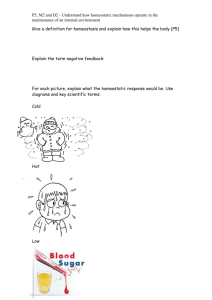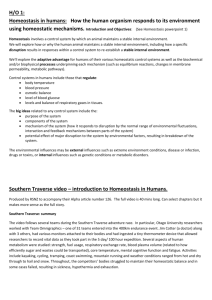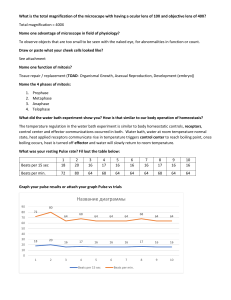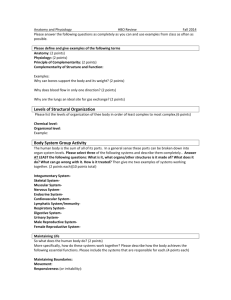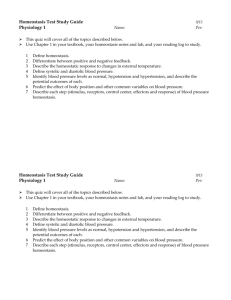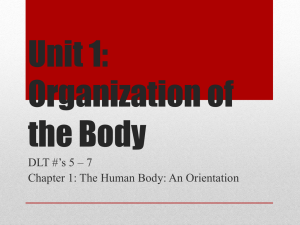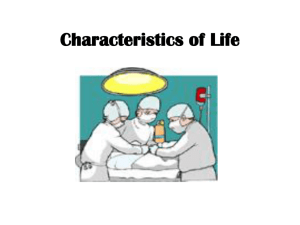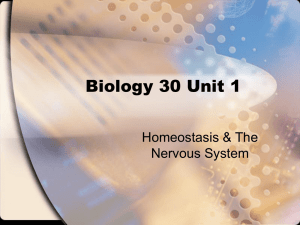Homeostasis
advertisement
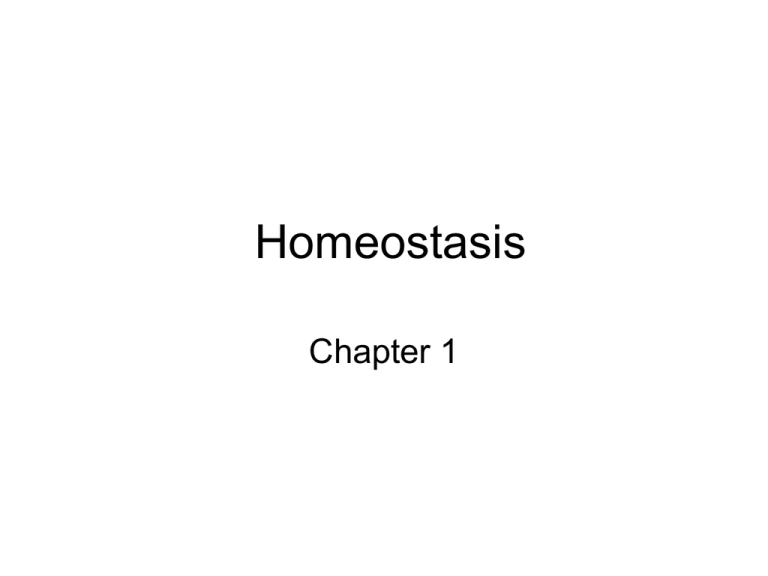
Homeostasis Chapter 1 Learner Outcome: • To discover and describe homeostatic regulation in the human body and predict the consequences of the failure to maintain homeostasis. Question: • Are a cough and sneeze examples of positive or negative feedback? • A: Cough is caused as the body’s mechanism of removing harmful particles (bacteria, etc.) from lungs & throat. Sneeze is involuntary reaction that expels same reactants from sinus passages. Generally accepted answer is NEGATIVE* b/c in response to a perturbation, a negative feedback system will tend to re-establish equilibrium. Defined • Homeostasis is the relative constancy of the body’s internal environment. • External (environmental) conditions may change drastically. • Dynamic Equilibrium • If internal conditions change to a large degree – the result is illness. Terminology • Normal Range – a range of values for a variable that allow for normal function of the body and its tissues. • Set Point – the ideal value of a variable. • Sensor – the part of the body that detects an internal environmental change and signals the regulatory center. • Effector – the part of the body that receives the information from the regulatory center and reverses or amplifies the change. • Regulatory Center – part of the body that recognizes values outside of the normal range and activates the effector. Negative Feedback • Homeostatic mechanism that keeps a variable close to a particular value or set point. Fig. 1.7a Negative Feedback Fig. 1.7b Mechanical Example Fig. 1.8 Positive Feedback • Homeostatic mechanism that brings about an even greater deviation from the set point. • EX: Birth process Baby Cervix stimulates secretion of oxytocin from pituitary causes uterine contractions etc. Disease • The result of homeostatic failure and the malfunctioning of the structure due to that failure. • Local diseases are located in a specific area of the body whereas systemic diseases affect the entire body. • Acute diseases occur suddenly and usually last a short time whereas chronic disease tend to be severe and long term. Homeostasis Lab • Research Question: Are breathing rate, pulse rate and blood pressure positive or negative feedback mechanisms as a reaction to aerobic activity? Blood Pressure Background… • BP is pressure exerted by blood flowing against walls of blood vessels throughout body. • Heart provides force for blood to flow. When heart beats, blood is forced through the vessels increasing the pressure. This is highest pressure in the cycle, referred to as SYSTOLIC BLOOD PRESSURE. • In between beats, heart relaxes and BP decreases. This is DIASTOLIC BP. • Complete series of events occurring in single heartbeat is called CARDIAC CYCLE. • Measured in millimeters (mm) of Mercury (Hg). Systolic/Diastolic • Normal range is 120-129/80-84 mmHg; Optimal is <120; <80 Tips for using BP cuff • Place on left wrist; place elbow on table and raise hand until cuff is level with the heart. • Don’t do anything while taking reading (talk, move, etc) body should be in relaxed state. • Rest 15 min. prior to taking reading. Remove constrictive clothing or jewelry from wrist. Lab Tips • Plan for a minimum of 4 trials. Each trial needs to be the same exercise run for the same length of time. • Plan to have 4-5 minutes in between each trial. • Each trial should last 2-3 minutes. • 40-45 minutes total for the exercises. Data Table Variable BR (set pt.) PR (set pt.) BP (set pt.) Trial 1 Ex. Trial 2 R Ex. Trial 3 R. Ex. R.
